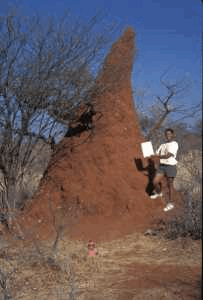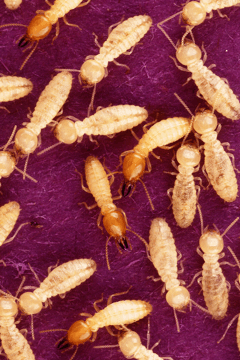Tiny Architects
Air Date: Week of October 16, 2009

Termite mounds like pepper the landscape of Southern Africa (Photo: J. Scott Turner)
They are just the size of pin heads but termites are giving us big ideas about efficient green buildings. Living on Earth’s Steve Curwood spoke with J. Scott Turner, who teaches biology at the State University of New York in Syracuse, about what we can learn from these tiny builders.
Transcript
YOUNG: We usually think of termites as demolition experts, but apparently they are brilliant architects as well. J. Scott Turner, who teaches biology at the State University of New York at Syracuse, thinks that human builders have a lot to learn from termite mounds, especially the way they harness the wind. Living on Earth’s Steve Curwood spoke with Professor Turner about how these tiny insects build such green homes.
TURNER: Well, the secret of the termites is that they've learned how to exploit a kind of wind energy that most engineers and architects regard as a kind of nuisance. This kind of wind energy is turbulent wind energy. Every time you go out into a kind of windy environment and you hear the wind hissing past your ears, that’s turbulent wind energy and it’s the most common form of wind energy that’s out there, but for a long time wind engineers have kind of looked down upon.
CURWOOD: So, I understand part of your discovery and realization involves, well, almost music. Is there some sort of resonance in these mounds?
TURNER: Well, now if you open up one of these termite mounds, you see that there’s not just a single tube, there’s a network of tubes. But the remarkable thing about them is that they’re very, very long and they’re relatively straight, of course, they undulate around back and forth, but for the most part they’re vertically oriented.

Despite their small size these subterranean termites build some of the biggest structures in the animal kingdom. (Photo by Scott Bauer)
The way it works is that the superficial tunnels, they tend to resonate at fairly high frequencies, but as you go deeper and deeper into the mound and the nest, this network of tunnels actually helps to kind of tune out these higher frequencies and you get a kind of a different tone of vibration going on deep in the mound and this kind of tuning function that the mound engages in – this tuning of the messy energy and turbulent winds is crucial to these mounds ability to breathe and to help maintain the climate inside the nest.
CURWOOD: So, let me see if I have this right: what happens here is you have – the termite make a bunch of tubes, they’re kind of like musical instruments, like a bunch of clarinets or something, or maybe an organ, a pipe organ structure there – and the vibration of the sound, the vibration of the wind really helps move the air through for the ventilation. How does that work?
TURNER: Well, you have a number of different tubes just like in a pipe organ where you have one tube that corresponds to one note. If you connected all those tubes together you would get kind of a hissing sound that ranges from a fairly high-pitched hiss at the surface to a very low frequency, almost a sigh-like movement of air deep within the mound and nest. And these nests can get to be quite a stuffy affair, there’s a lot oxygen consumption and heat production down there, and in order for them to be able to tolerate that and live, they have to have someway of being able to ventilate that nest, and the mound is the way they do it.
CURWOOD: So, how applicable is this science to heating and cooling the buildings we’re in? Frankly, you know, we use a lot of energy heating and cooling.
TURNER: Well, this is the dilemma in modern architecture. You know, as you say, we build a building by creating a wall, you know, walling off a space from the outside and then we spend a great deal of energy and materials reconnecting that space to the outside. But what needs to be done is to actually rethink the whole concept of the wall. We normally think of the wall as an impermeable barrier, but in the case of termite mounds, their wall, if you will, the outside of the mound, is basically a tuned interface between the inside environment and the outside environment.

Termite mounds pepper the landscape of Souther Africa (Photo credit: Jay Scott Turner)
And the secret of being able to do this for all buildings is to be to reproduce the complex structure that enables termites to do this. So, our thinking is that if you can somehow replace impermeable walls with these kinds of structures that can actually tune the inconvenient energy that’s in turbulent wind, then you’re opening the door to, I think, a revolution to the way we think about wind technology. You can have not only ventilation for free in any building, but we’re working on designs that can enable the control of humidity, perhaps even wind-powered air conditioning in ordinary buildings. So, mainly by exploiting this untapped band of wind energy that’s out there.
CURWOOD: So, what’s the closest existing human habitat to a termite mound?
TURNER: Well, you find a lot of traditional architecture, what’s sometimes called vernacular architecture, and some of the most interesting examples of this are in North Africa. You see castles built from sand and clay, and they incorporate many of the same features that the termite mounds use. This kind of idea has actually been available in vernacular architecture for a long time. Back in the 1990’s though, mid-1990’s, one of the pioneering buildings in this was a building called the Eastgate Center, which was constructed in Harare, Zimbabwe by an architect named Mick Pearce.
And he had a very interesting philosophy, which is resonating quite strongly these days in, namely, if you build a building in an environment, especially a harsh environment like the tropics, you should look to inspiration to animals that live there and live there comfortably for the designs that you incorporate. And Mick Pearce did this in the Eastgate Center and his idea was so captivating that actually many architects are now looking into ways of using wind energy in imaginative ways to be able to accomplish what we now burn lots of fossil fuels to accomplish.
CURWOOD: Professor, one thing about this idea, though. Are people going to have to listen to music inside these tuned buildings? I mean, and if so, would you be able to get like one that plays the Beatles as opposed to Bach, or something?
TURNER: Playing the Beatles as opposed to Bach would be a tall order, definitely. But, the good news here is that you can actually implement these things at sounds frequencies actually below the range of human hearing, so at the most you may hear a nice gentle hiss or a sigh, but most of the work is going to be done at frequencies actually below the level at which you can hear.
YOUNG: That’s Professor J. Scott Turner talking with Living on Earth’s Steve Curwood.
Links
Living on Earth wants to hear from you!
Living on Earth
62 Calef Highway, Suite 212
Lee, NH 03861
Telephone: 617-287-4121
E-mail: comments@loe.org
Newsletter [Click here]
Donate to Living on Earth!
Living on Earth is an independent media program and relies entirely on contributions from listeners and institutions supporting public service. Please donate now to preserve an independent environmental voice.
NewsletterLiving on Earth offers a weekly delivery of the show's rundown to your mailbox. Sign up for our newsletter today!
 Sailors For The Sea: Be the change you want to sea.
Sailors For The Sea: Be the change you want to sea.
 The Grantham Foundation for the Protection of the Environment: Committed to protecting and improving the health of the global environment.
The Grantham Foundation for the Protection of the Environment: Committed to protecting and improving the health of the global environment.
 Contribute to Living on Earth and receive, as our gift to you, an archival print of one of Mark Seth Lender's extraordinary wildlife photographs. Follow the link to see Mark's current collection of photographs.
Contribute to Living on Earth and receive, as our gift to you, an archival print of one of Mark Seth Lender's extraordinary wildlife photographs. Follow the link to see Mark's current collection of photographs.
 Buy a signed copy of Mark Seth Lender's book Smeagull the Seagull & support Living on Earth
Buy a signed copy of Mark Seth Lender's book Smeagull the Seagull & support Living on Earth

